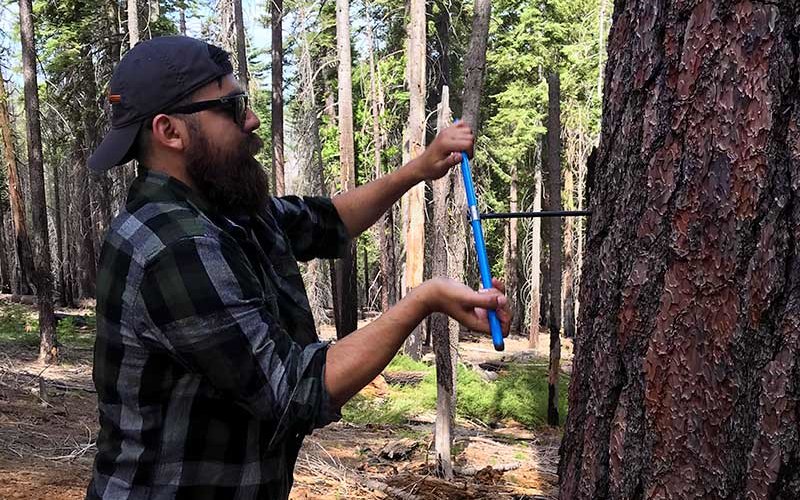
As droughts and fires continue to challenge California, Trevis Matheus believes tree rings can reveal patterns in a region as well as offer clues about the future.
The Cal State Fullerton assistant professor of geography and the environment, who specializes in dendroclimatology, took eight students in his “Mountain Field Geography” class to Sequoia and Yosemite national parks for 10 days over the summer to learn how to sample trees.
The sites they visited were previously sampled in the 1970s and 1980s with a focus on precipitation totals. With new methodology, CSUF researchers are hoping to reconstruct snowpack totals in the Sierra Nevadas over the last 500 to 1,000 years.
“What we can do is look at light bands in tree rings and correlate that to snowpack,” said Matheus. “Looking at snow, rather than runoff, is an important distinction because it is the source of our water supply.
“When we have droughts, they might seem severe on a local time scale, but the trees are going to report how droughts fit into a long-term context and give us some idea of what we can expect for the future.”
The team also sampled trees at a site in Yosemite that burned a few years ago. The data could lead to an offshoot of research focusing on dendropyrology, which examines fire scars in trees.
“Every time a tree burns, it will have a scar,” said Matheus. “Looking at the scars under a microscope, you can determine when a fire occured in a tree. If you can sample enough trees over a large area, you can also determine how widespread the fires were and how common they are.”
By examining how far apart or close together the rings are, researchers can determine how well the trees that did survive are growing after a fire, he added.
For every hour the researchers are in the field, Matheus estimates that they return home with approximately five to eight hours of lab work. The lab work will be conducted in CSUF’s new Cal-Dendro Tree Ring Laboratory, which houses field sampling gear, two microscopes, sanding equipment and a computer to analyze the data.
“I’m always looking for help in the lab if people want to gain experience,” said Matheus, who anticipates that two to three papers will result from this summer’s trip.
Graduate student Raymond Villalba is using the lab to work on his thesis project on the growth response of sugar pine (Pinus lambertiana) in the Sierra Nevada Mountains.
Villalba described the summer field work as “mentally and physically challenging” — waking up at 5:30 in the morning and hiking several hours through steep terrain to reach sites up to 10,000 feet high — and “a great experience” he will never forget.
The process of sampling included drilling into a tree and extracting two pencil-sized cores — which doesn’t harm the trees — recording the latitude and longitude of the tree, measuring the diameter of the tree, and using an inclinometer to estimate the height of the tree. Matheus and his students sampled 80 trees in total.
“Sometimes when you pull out the core, it comes out in pieces, so it can be frustrating,” said Villalba. “But I’m growing this love for dendrochronology and I want to keep doing this.”
With climate change a global concern, Villalba’s goal is to teach geography at the community college level to help educate future policymakers.
“Maybe someone who is planning to be a lawyer, a politician or an engineer will learn more about the environment in one of my classes,” he said. “Maybe that’s the contribution I can make to this world.”